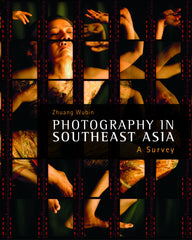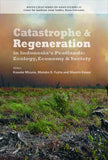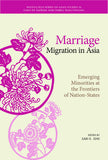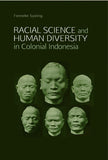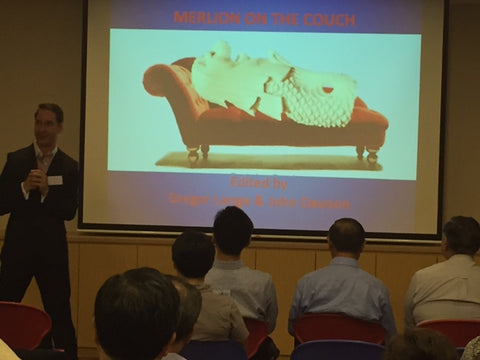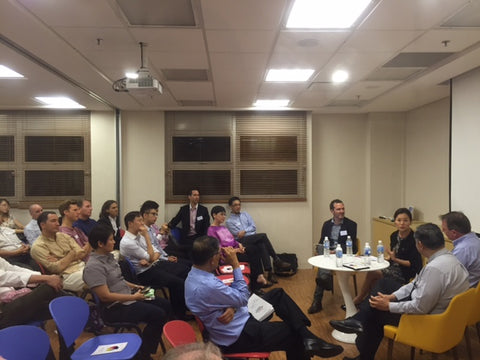News
Follow NUS Press on
The Grand Duke, the tiger and the buffalo November 13, 2019 16:54
An extract from Imperial Creatures: Humans and Other Animals in Colonial Singapore, 1819–1942,
by Timothy P Barnard
Chapter Four: Defining Cruelty
In 1872 Alexei Alexandrovich, better known as Grand Duke Alexis, the fifth child of Czar Alexander II of Russia, visited Singapore along with a squadron of naval vessels. His sojourn in the capital of the Straits Settlements was part of a longer diplomatic journey that involved an extended tour of the United States as well as stops in Rio de Janeiro, Cape Town and Batavia, and eventually Hong Kong, Canton and Shanghai. Grand Duke Alexis was headed to Japan, where he was to meet with members of the Meiji government and participate in discussions on Russo-Japanese diplomatic relations. While in Singapore he met with Governor Harry Ord and attended dinners and balls in his honor, amidst surging crowds and all of the trimmings of pomp and circumstance. The presence of foreign royalty brought some life to the colonial port. As one observer opined, it was “an agreeable interlude in the sleepy monotony and sameness which characterizes life in this so-called Paradise of the East.” The visit was originally scheduled for three days, but went so well the Grand Duke extended his stay for over a week, and even made a visit to Melaka.1
One of the highlights of this brief sojourn in the Straits Settlements occurred on 31 August. That morning, accompanied by the Governor and much of the elite of Singapore, Grand Duke Alexis boarded the government steamer Pluto and sailed around the island to the newly founded town of Johor Baru. The visitors alighted at the bungalow of the Maharaja of Johor, Abu Bakar, who was an influential supporter of the British presence in the region. The Johor royal family, Chinese entrepreneurs and the European elite of the port had been closely interlinked since 1819. The grandfather of the Maharaja was the Temenggong of Singapore who had signed the original treaties with Thomas Stamford Raffles and John Crawfurd in 1819 and 1824 respectively, which transferred sovereignty of the island to the British East India Company. Abu Bakar and his father continued to support the colonial government and its policies in the following decades as they expanded their influence and agricultural policies into the southern portions of the Malay Peninsula. The Maharaja eventually became so intertwined with the imperial elite, and their culture, his British friends referred to him as “Albert Baker,” and the visit of the Grand Duke to Johor was part of the larger theater-state of colonial society in Singapore.2
The Maharaja greeted his guests upon their arrival and accompanied them to a large tent in the courtyard of the bungalow, where a sumptuous breakfast was laid out. After the meal and several speeches, everyone retired to an area behind the building, where they saw a large cage consisting of “long poles driven into the ground and tied together with thongs, and made firm by strong cross-pieces at the top.” The Maharaja of Johor was about to entertain his guests with a contest between a “royal tiger and a buffalo bull.”3
Such spectacles were commonly staged in royal houses throughout Southeast Asia in the premodern era. As Anthony Reid states in a survey of such entertainment, “No great feast passed at the courts of Java, Aceh, Siam and Burma without some spectacular fight between elephants, tigers, buffaloes, or lesser animals.” J.F.A. McNair, a Briton who served as Head Engineer for the Straits Settlements and attended the breakfast that morning in Johor, described such events as “the grand national sport” of Malay polities. It was not the first time McNair had attended such a contest in Johor. Only three years earlier, he was present when the Duke of Edinburgh witnessed a similar confrontation—which would have the same outcome—during his visit to the Straits Settlements.4
A curtain divided the cage in half and, after Grand Duke Alexis and the other guests were readied, the two animals were admitted into opposite sides of the pen. As described in a newspaper report:
Beyond the symbolism of such a contest in a Southeast Asian polity, this staged spectacle, held for the elite of the Straits Settlements in 1872, was also a metaphor for a shift in animals and their importance in Singapore. The tiger was no longer much of a concern for residents of the growing port. The jungle had been tamed, its predators destroyed, and in this case even converted into a form of symbolic entertainment. In contrast, the buffalo—or, more specifically its close relative, the bullock—was about to become the most important animal on the island, where it would play a role in transporting peoples and goods while reflecting attitudes towards animals that would reveal many of the permutations of British imperial rule in Southeast Asia as well as the development of colonial Singapore. The bullock thus would play a role in transforming the island during a period when animals provided much of the labor in transporting goods and people throughout the region, and power structures within the colonial government were becoming clearer. This also would be reflected in how humans perceived other animals, and treated them, particularly those that provided labor.
----------------------------------------------
1 CO273/59/10138: Arrival and Departure of Corvette “Sveltana” with Grand Duke Alexis Aboard; Anonymous, “The Grand Duke Alexis at Johore,” ST, 7 Sep. 1872, p. 1; Anonymous, “The Grand Duke Alexis,” ST, 31 Aug. 1871, p. 1; Anonymous, “Untitled,” Straits Times Overland Journal, 7 Sep. 1872, p. 11.
2 R.O. Winstedt, A History of Johore (1365–1941) (Kuala Lumpur: Malaysian Branch of the Royal Asiatic Society, 1992), p. 137; Carl A. Trocki, Prince of Pirates: The Temenggongs and the Development of Johor and Singapore, 1784–1885 (Singapore: NUS Press, 2007), pp. 128–60; Anonymous, “She Cannot Sue the Sultan,” The Chicago Sunday Tribune, 5 Nov. 1893, p. 1; Anonymous, “The Grand Duke Alexis at Johore.”
3 Anonymous, “The Grand Duke Alexis at Johore.”
4 J.F.A. McNair, Perak and the Malays (Kuala Lumpur: Oxford University Press, 1972), pp. 266–8; Boomgaard, Frontiers of Fear, p. 14; Reid, Southeast Asia in the Age of Commerce, 1450–1680. Volume One, p. 183.
5 Anonymous, “The Grand Duke Alexis at Johore.”
6 Anonymous, “The Grand Duke Alexis at Johore”; Reid, Southeast Asia in the Age of Commerce, Volume One, pp. 183–91; Boomgaard, Frontiers of Fear, pp. 146–66.
Enjoyed this excerpt? Buy the book here!
Five Minutes with Samuel Ling Wei Chan May 15, 2019 09:42
I n April this year, Dr Samuel Ling Wei Chan published "Aristocracy of Armed Talent, The Military Elite in Singapore". It explores the Singapore Armed Forces by a comprehensive and in-depth examination of its elite leadership: the 170 men (and a very few women) who served or serve as flag officers, that is generals or admirals. How did Singapore build a culture of leadership for its armed forces? What role did the SAF Scholars scheme, introduced in 1971, play in forming this culture?For this edition of Five Minutes With... we turned to noted military expert and journalist David Boey, who conducted this interview and first ran it on his excellent blog on Singapore military matters, Senang Diri. Thanks to David for the interview and for giving us permission to run it on the website.
n April this year, Dr Samuel Ling Wei Chan published "Aristocracy of Armed Talent, The Military Elite in Singapore". It explores the Singapore Armed Forces by a comprehensive and in-depth examination of its elite leadership: the 170 men (and a very few women) who served or serve as flag officers, that is generals or admirals. How did Singapore build a culture of leadership for its armed forces? What role did the SAF Scholars scheme, introduced in 1971, play in forming this culture?For this edition of Five Minutes With... we turned to noted military expert and journalist David Boey, who conducted this interview and first ran it on his excellent blog on Singapore military matters, Senang Diri. Thanks to David for the interview and for giving us permission to run it on the website.
How long did it take you to write the book?
The book is a revised and updated edition of my PhD thesis. I started my studies in March 2011 but by February 2012 it was apparent that my initial topic (on military education in Australia and the US) was not tenable.
What made you press on with research on the SAF despite initial hurdles?
It was a challenge to complete a puzzle and I was focused on the task at hand. The topic is interesting to me, both in academic and general terms.
What was the most challenging aspect of the research for this book?
The most challenging aspects were access to information in terms of open source material and interviews for the specific questions that I had in mind.
How did you go about resolving the challenge(s)?
The 28 interviews were great and a blessing in terms of being able to get the work done.
Which chapter did you enjoy researching/writing most?
I must say I enjoyed them all due to the variation, focus, and information in each of the chapters.
What are the takeaways you hope the reader will glean from the book?
To appreciate the SAF in its entirety, both the good, the quirky, and the not so good.
Launch of "Nature's Colony" at the Singapore Botanic Gardens October 21, 2016 11:00
Timothy Barnard launched his latest book, Nature’s Colony: Empire, Nation and Environment in the Singapore Botanic Gardens, at the Singapore Botanic Gardens on October 14, as part of the Gardens' regular speaker series.


(Photos courtesy of Sebastian Song)
Professor Barnard centred his talk around the history of the Gardens and its broader impact beyond its bounadries in environmental, political, and
social terms.


(Photos courtesy of Sebastian Song)
Professor Barnard explained that the botanic gardens was established as a private park between 1869 and 1874. By the early 1870s, the British realised that it had the potential of becoming a key colonial institution because imperial botany was seen as a tool that could strengthen empire (i.e. rubber seeds could be harvested in Singapore and Malaya, which could then be traded as a commodity).
The ever-changing position of the Singapore Botanic Gardens in society and politics over time has also often been overlooked: Professor Barnard emphasised the Gardens' precarious position as a colonial institution in a decolonialising society in a post-Merdeka era.
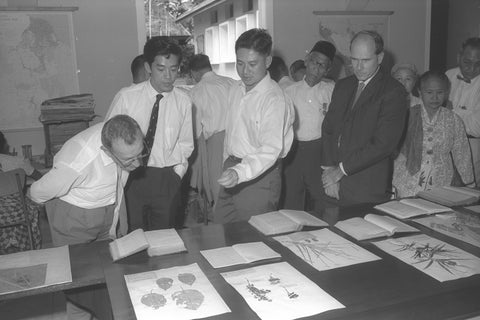
Humphrey Burkill, Director of the Singapore Botanic Gardens from 1957 to 1969, leading a tour of government officials at the opening of the “renovated” herbarium in October 1964 (Source: Ministry of Information and Arts Collection, courtesy of the National Archives of Singapore).
One of the highights of the talk was a segment on Henry Ridley, the Director of the Singapore Botanic Gardens between 1888 and 1912. Ridley was seen as “mad” by many of his contemporaries within the colonial government in Singapore due to his quirks and views of how the Singapore Botanic Gardens should be developed.
Ridley accomplished a lot during his tenure as director—from overseeing the set up of a short-lived zoo (1875-1905), to the establishing an Economic Garden within the park. Ridley also had the foresight to see that planting oil palm would have economic advantages for the region.

Henry Ridley with a small panther (Image reproduced with the kind permission of the Board of Trustees of the Royal Botanic Gardens, Kew).
The talk was followed by a lively question and answer session that was moderated by the Group Director of the Singapore Botanic Gardens, Dr Nigel Taylor.

(Photo courtesy of Sebastian Song)
At the end of the talk, many queued up patiently for Barnard to sign their copies of Nature’s Colony.



(Photos courtesy of Sebastian Song)
We would like to thank the Singapore Botanic Gardens for hosting the launch. If you would like to hear snippets of what Barnard said that day, you can check out his interview with talkshow host, Michelle Martin, on 93.8 Live’s Culture Café here, where he discussed his book and the history of the Gardens.
NUS Press Book Launches in October 2016 October 7, 2016 15:00
October is looking up to be a very busy but exciting month for us with three book launches taking place in Singapore!
|
BOOK LAUNCH & DIALOGUE
|
|
AUTHOR TALK & BOOK LAUNCH
|
|
BOOK LAUNCH
|
NUS Press at the 2016 ASEASUK Conference September 16, 2016 12:30
NUS Press is pleased to be part of the 2016 edition of the Association for Southeast Asian Studies in the United Kingdom (ASEASUK) Conference at the School of Oriental and African Studies (SOAS). Held over three days this weekend (16-18 September), it is set to be the largest ASEASUK conference, with over 40 panels discussing a wide variety of topics.
NIAS Press is representing NUS Press at the event and will be displaying our books. Here’s a highlight of some titles:
|
|
- Catastrophe and Regeneration in Indonesia's Peatlands: Ecology, Economy and Society
- The Oil Palm Complex: Smallholders, Agribusiness and the State in Indonesia and Malaysia
- Marriage Migration in Asia: Emerging Minorities at the Frontiers of Nation-States
- Central Banking as State Building: Policymakers and their Nationalism in the Philippines, 1933-1964
- Electoral Dynamics in Indonesia: Money Politics, Patronage and Clientelism at the Grassroots
- Tall Tree, Nest of the Wind: The Javanese Shadow-play Dewa Ruci Performed by Ki Anom Soeroto - A Study in Performance Philology
- Pan-Asian Games and the Emergence of Modern Asia, 1913-1974
- Racial Science and Diversity in Colonial Indonesia
Dr Paul Kratoska, Publishing Director of NUS Press, will be also attending the Conference.
Do drop by to find out more about NUS Press and to browse our selection!
The Countdown to the 2016 Singapore Writers Festival has Begun! September 9, 2016 12:14
On September 6, members of the press and Singapore’s publishing scene gathered at Bhaskar’s Arts Academy for a media conference, where Singapore Writers Festival (SWF) director, Yeow Kai Chai, unveiled a solid line-up of writers and events for this year's festival.
Themed “Sayang,” the 19th edition of the festival will feature close to 330 acts between November 4-13 . The festival has also attracted big-names such as Eka Kurniawan, Lionel Shriver, Joanne Harris, German investigative journalist Frederik Obermaier, who helped to coordinate the Panama Papers expose, as well as Gosho Aoyama, the Japanese creator of the popular manga series Detective Conan.

"Sayang," illustrated by Esther Goh from the Organisation of Illustrators Council Singapore. (Image courtesy of Singapore Writers Festival)
We also got sneak previews of what the festival has to offer, including a performance of “Sayang di Sayang,” by M Saffri A Manaf and Mr GT Lye from the third edition of Malam Lawak Sastera (Literary Comedy Night), co-presented with Berita Harian.
NUS Press authors such as Alfian Sa’at, Boey Kim Cheng, Cyril Wong, O Thiam Chin, Jason Erik Lundberg, Ng Yi Sheng, Yu-Mei Balasingamchow, Mrs Ann Wee, Kevin Tan, Philip Holden, and Simon Tay (to name just a few), will also be appearing at the festival.
Mrs Wee will be speaking at the Arts House on November 6. She will be talking about stories not found in Singapore history textbooks, based on her recollections in her forthcoming book, A Tiger Remembers: The Way We Were in Singapore.

We are also excited to announce that we will be participating in "The Paper Trail: A Backroom Tour of Singapore Publishers," led by award-winning poet Yong Shu Hoong, on November 5 (Saturday). The Press is one of five publishers to be featured in this tour, where participants will get to find out what publishers of different genres and languages do behind the scenes to bring the printed word to life. Tickets for this tour are now available.
Watch this space for more NUS Press-at-SWF news!

Book Launch of Walter Woon’s The ASEAN Charter: A Commentary November 19, 2015 14:31

from left: Former Foreign Affairs Minister George Yeo, Professor Walter Woon, Professor Tommy Koh, former Senior Minister S. Jayakumar, and NUS Press Director Peter Schoppert.
Professor Walter Woon’s The ASEAN Charter: A Commentary was launched on 13 November 2015 at the NUS Faculty of Law.
The ASEAN Charter comments on the provisions of the 2008 Association of Southeast Asian Nations (ASEAN) Charter, which established ASEAN’s legal status and institutional framework. Professor Woon, a Member of the High Level Task Force that drafted the Charter and Singapore’s former Attorney-General, crafts an insider’s perspective on the making of the Charter, elucidates how its provisions came to be drafted, and how they relate to diplomatic practice. As both former Foreign Affairs Minister George Yeo and Singapore’s Ambassador-at-Large Professor Tommy Koh eulogised during the launch, The ASEAN Charter is a very important and useful reference text for ASEAN officials and scholars, as well as members of the public who are interested in the organisation.
George Yeo on the “magic of ASEAN”
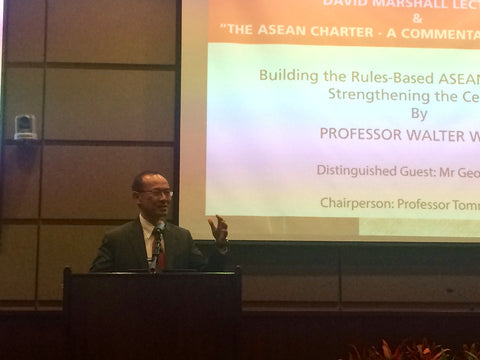
Graced by the likes of former Senior Minister S. Jayakumar as well as numerous members of the legal community, the launch of The ASEAN Charter commenced with a few words from George Yeo in praise of ASEAN. Highlighting Myanmar's National League for Democracy’s latest victory at the polls, Yeo attested that this outcome was in part a “triumph of ASEAN”. Indeed, such is the “magic of ASEAN”—a space that allows room for disagreement, evolution, and provides time for the branch to gradually bend, Yeo affirmed. Continuing in this positive vein, Yeo concluded that that despite criticisms, ASEAN has not only kept the peace in the region, but is also a historical necessity that will hold together with time.
ASEAN: Rolls-Royce ambition, Volkswagen model

Less sanguine about ASEAN was Professor Woon in his professorial lecture on the imperative to build a rules-based ASEAN community and strengthen the association’s centre.
Professor Woon stressed that ASEAN is “in essence not a legal institution”, having begun its life as a confidence-building mechanism for bickering countries and continued with an “ASEAN way” of being ad hoc. Accordingly, the formal rules that the ASEAN Charter intends to set in place do not sit well with ASEAN practice. Seen from this perspective then, ASEAN appears to have the “ambition to create a Rolls-Royce organisation, but fit[s] it with a Volkswagen model with dodgy software”. Professor Woon ultimately compared the Charter to a camel, being serviceable but inelegant.
What could upgrade ASEAN to become a full-fledged Rolls-Royce vehicle then? Professor Woon flagged a few areas that could be improved. Firstly, a proper legal service with international lawyers was needed to establish a rule-making centre that would also ensure the coherence of and compliance with such rules. Another aspect that a rules-based organisation requires is a proper dispute settlement system, with ASEAN’s current system being designed to be ineffective, Professor Woon lamented. The fact that the ASEAN High Council has never been convened was cited as evidence of such ineffectiveness. Moreover, the bringing of disputes to political settings like the ASEAN Summit—as has been done—is fatal to ASEAN’s credibility as a rules-based organisation. Ending on a more ambiguous note, Professor Woon pondered the possibility of being able to celebrate this rules-based element in time with ASEAN’s jubilee year in 2016.
A camel on shifting sands: Tommy Koh on ASEAN

Professor Tommy Koh was able to draw the book launch to a more buoyant close. Picking up on Professor Woon’s earlier camel metaphor for the ASEAN Charter, Professor Koh defended the association by extolling the importance of the animal to the audience’s amusement. To be sure, the camel might lack elegance, but in Professor Koh’s words, the anatomy of its hoofs, for instance, allows it to walk across shifting sands—likewise then for ASEAN, in its ambitions and efforts over the years.
The ASEAN Charter: A Commentary is now available at NUS Press.
Alfred Russell Wallace the “forgotten” hero: Why is Darwin more famous than Wallace? October 2, 2015 17:01
Ask the man on the street about natural selection, and you are bound to hear the name Charles Darwin. Indeed, it would be easy to conclude from this that Darwin is the de facto founder of natural selection as a concept. Yet, in recent years many have pointed to the concomitant, independent discovery of natural selection by Darwin’s contemporary, Alfred Russell Wallace, and lament the paltry amount of credit accorded to him.
Dr John van Wyhe, a historian of science at NUS and the editor of The Annotated Malay Archipelago, debunked this apparently “forgotten” reputation of Wallace as Darwin’s equal at a lecture given at the Singapore Science Centre on 26 September 2015. Dr van Wyhe’s Annotated Malay Archipelago is the first ever fully annotated version of Wallace’s classic account of his travels in Southeast Asia to appear in English, updating the original text with explanations, a bibliography of related material, and an in-depth introduction. Wallace’s The Malay Archipelago was an immediate success following its publication in 1869. Captivating generations of audiences with its descriptions of places and people, the book even inspired the likes of Joseph Conrad and David Attenborough.
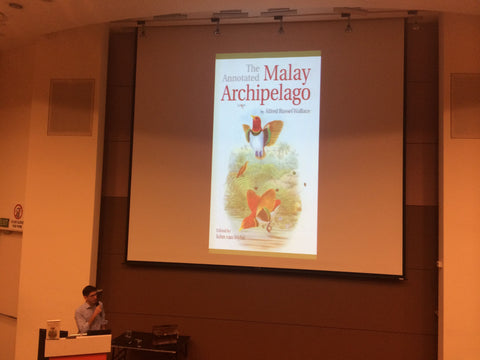
Wallace the “forgotten” hero: Why is Darwin more famous than Wallace?
Dr van Wyhe opened the lecture with the very question that many have recently posed in response to the independent discovery of natural selection by both Darwin and Wallace, namely – if this phenomenon was something that the pair had discovered (albeit separately), why is Darwin so much more famous than Wallace?
As an inquiry that began in the 1950s, this has since spiraled into claims – according to Dr van Wyhe – that Wallace was not only unjustly “forgotten” but also the “victim of a conspiracy”. Some have even put forward that Darwin had plagiarized Wallace’s work. In fact, the more books are written about Wallace, the more firmly his status as a “forgotten” hero seems to be cemented, Dr van Wyhe observed. Exaggerated statements thus abound about Wallace being “the greatest field biologist”, and even Black Books comedian Bill Bailey has exclaimed with injustice that natural selection “was known as a joint theory [by Darwin and Wallace] for decades!”
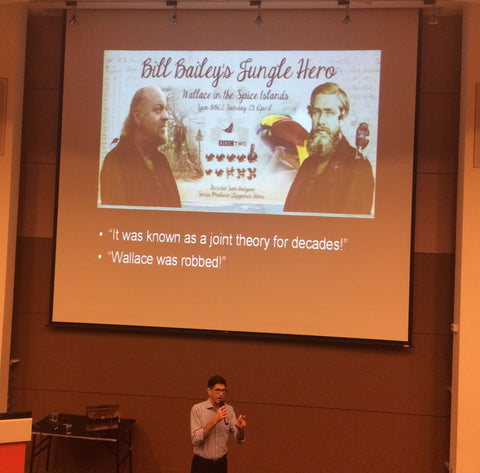
We might perceive Wallace to be unfairly left out of the limelight then, only because we have been told that this is so, Dr van Wyhe argued. Additionally, this “forgotten” descriptor of Wallace may perhaps have been arrived at with the false impression of Wallace’s relatively “humble background” that persuades one of his deserving better recognition. Wallace was certainly no peasant, having been sent to a school for gentlemen in his youth, for example.
The real, historical Wallace
If not a “forgotten” hero, who could the real Wallace be? After his school days and a voyage to the Amazon, Wallace arrived at Singapore in 1854, Dr van Wyhe delineated. It was here that Wallace made expeditions to Bukit Timah, trips which would form part of his material for The Malay Archipelago. Wallace’s influence as a naturalist still resounds among parts of the island today, with roads and nature trails named after him, for instance.
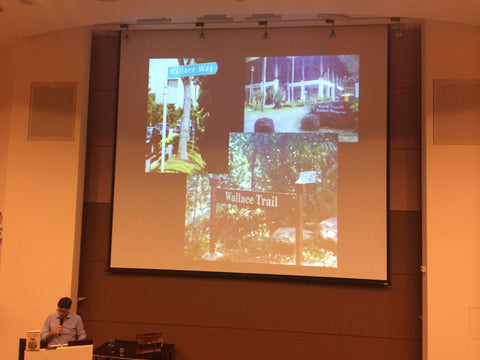
Southeast Asia was also where the idea of natural selection first came to Wallace in 1858. Penning down his thoughts on the subject, Wallace decided to first send these off to Darwin, who he felt would be sympathetic to ideas of such a nature. (These notions had previously also occurred to Darwin 20 years ago in 1838, though nothing had been published by him at that point.) Upon reception, the choice was made to have Darwin’s and Wallace’s ideas published together in a paper. However, very few took notice of this scholarship at that time.
With this piece of information, some might clamour again for the rightful recognition of Wallace’s role in discovering natural selection. Yet, more importantly, as Dr van Wyhe put it, the household recognition of only Darwin’s name today is quite simply because it was his book which had convinced people of the verity of natural selection. Wallace’s discovery notwithstanding, Darwin’s The Origin of Species still contained other numerous ideas that Wallace had never conceived of, a fact that the latter freely admitted to. Indeed, Wallace was even part of the flurry of voices commending Darwin’s unprecedented work at that time. Rounding things up, it may perhaps be more accurate then to view the Wallace-Darwin relationship as one filled not so much with animosity, but academic camaraderie, Dr van Wyhe concluded.
The Annotated Malay Archipelago is now available at NUS Press.
Book Launch of Clinical Psychology in Singapore September 22, 2015 13:41
Dr Gregor Lange and Dr John Davison’s book, Clinical Psychology in Singapore: An Asian Casebook, was launched at the Brahm Centre in Ren Ci Hospital, on 17 September 2015.
As an unprecedented look into clinical psychology and its practices in Singapore, the book offers case studies based on Singaporean clients, and sheds light on how psychologists deal with the different cultural and ethical issues encountered in their work here. These case studies encompass a range of mental health problems ranging from pyromania to depression, and span across age groups as well. Notably, the casebook came together with contributions from numerous members of Singapore's psychology community, many of them being present among that evening's audience of academics, practitioners, and members of the general public.
The launch was an occasion packed with as many laughs as there were moments of more sombre reflection – this perhaps being not unlike the ups and downs faced in engaging with clinical psychology in Singapore so far.
Q: What is the state of mental health in Singapore? A: Stateless
Dr Ong Lue Ping, IMH's Principal Clinical Psychologist, kicked off the event with his talk on the state of mental health in Singapore.
His pronouncement was – in Dr Ong’s own words – most “provocative”, for he went on to declare Singapore’s state of mental health as being, in fact, “stateless”. Though this was met with some amusement from the audience, Dr Ong lamented the real dilemma encountered in this. On one hand, psychologists in Singapore hospitals are still expected to “defer” to doctors and psychiatrists. Yet, on the other hand, independent psychologists working outside of this system are often simultaneously seen by the public as being “atas”. Undeterred by this, Dr Ong rounded things up by proposing three factors that had to be attended to equally in clinical psychology – namely accessibility, quality, and affordability – in order to rectify existing flaws in practice.
Merlion on the couch
A streak of joviality was picked up again in Dr Lange’s address. Regaling the audience with how he and Dr Davison had edited Clinical Psychology in Singapore together, Dr Lange sent people up in laughs by joking that one of the more exciting titles actually considered for the casebook was none other than Merlion on the Couch.
Such irreverent humour aside, Dr Lange also spoke about why he and Dr Davison decided to embark on such a book. While teaching psychology at NUS, it was a revelation for the both of them that case studies to be used always took place in the US or other parts of the West. This difference in setting – which could range from the usual Hollywood celebrity gone mad profile to the scenario of a cocaine-taking young adult in downtown LA, Dr Lange explained animatedly – was something that students here frequently could not relate to. Yet, there was a dearth of resources in the local context that could be utilized in class. The need for a casebook designed for Singapore thus arose.
Of paradoxes and paychecks
Next was an expert panel on the future of clinical psychology in Singapore, including Ms Jennifer Teoh, Director and Senior Principal Forensic Psychologist at MSF’s Clinical and Forensic Psychology branch, Dr Simon Collinson from NUS, and Mr Timothy Leo, Director of the Psychological & Correctional Rehabilitation division at Singapore Prison Service.
Intriguingly, Dr Davison asked the panel about a paradox that seems to play out in Singapore - that is, the fact that it is often difficult to involve the client’s family in therapy, despite how Singapore is ‘supposed’ to be a country rooted in collectivism. To this, Ms Teoh shared that the MSF started a functional family therapy scheme a year ago that would enable the whole family to be seen together outside of working hours, thus perhaps resolving the practical complications that contribute to this situation. Dr Collinson further suggested that there has to be an improvement in the training offered in family therapy, so as to better ease families into being engaged throughout the process.
Besides this, Mr Leo also remarked that the biggest challenge for psychologists in the next five years should concern the respect for psychology as a science. Making the timely observation that psychologists like Dr Daniel Chan were involved in the media as commentators on the recent elections here, Mr Leo commented that such screen time should be seen as good opportunities for the discipline, and more psychologists could follow suit to step up to the plate in terms of advocacy.
Finally, closing the discussion on a lighter note, Dr Davison fired a series of quick questions at the panelists, one of these being on whether psychologists in Singapore should be paid more. To which all three panelists chorused in unison: “Yes.”
Clinical Psychology in Singapore: An Asian Casebook is available at NUS Press and Kinokuniya Singapore Main Store. Clinical Psychology in Singapore is a unique resource on the practices and principles of clinical psychologists in Singapore. An ideal complement to abnormal, counselling or clinical psychology courses, it is the textbook for PL3236 Abnormal Psychology at the National University of Singapore and will be a supplementary text for Temasek Polytechnic’s Abnormal Psychology module by April 2016. Please email sebastian_song@nus.edu.sg for all enquiries on textbook adoption and review copies.
NUS Press attends 22nd Beijing International Book Fair August 25, 2015 15:12
NUS Press will be attending the upcoming Beijing International Book Fair from 26 to 30 August 2015. The Fair will be held at the China International Exhibition Center (Shunyi), featuring five exhibition halls with 66,000 square meters of exhibition space.
NUS Press will be part of the Singapore contingent, displaying our books at East Hall 2 (E2) Booth J20. Director of NUS Press, Peter Schoppert, will be attending the fair so do drop by our booth to find out more about NUS Press and to browse our selection.
Here’s a highlight of some titles:
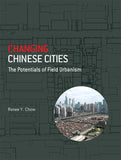 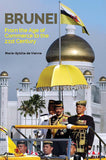 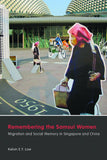 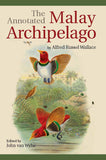  
|
- Changing Chinese Cities: The Potentials of Field Urbanism
- Brunei: From the Age of Commerce to the 21st Century
- Remembering the Samsui Women: Migration and Social Memory in Singapore and China
- The Annotated Malay Archipelago by Alfred Russel Wallace
- Community, Commons and Natural Resource Management in Asia
- State and Finance in the Philippines, 1898-1941: The Mismanagement of an American Colony
- Vietnamese Traditional Medicine: A Social History
We look forward to seeing you.
Philip Taylor wins 2015 Nikkei EuroSEAS Social Science Book Prize: Five NUS Press titles shortlisted August 19, 2015 16:40
We are pleased to announce that Philip Taylor has won the inaugural Nikkei EuroSEAS Social Science Book Prize awarded by the European Association for Southeast Asian Studies at a reception at the University of Vienna on 12 August 2015.
The Social Science Prize was awarded to Taylor for his The Khmer Lands of Vietnam: Environment, Cosmology and Sovereignty. "In this meticulous, absorbing and often poignant book, Philip Taylor draws on years of fieldwork to take us among the appealing, resilient and ecologically gifted Khmer speaking minority in southern Vietnam. This is the first book in any language to treat these beleaguered men, and women with the sustained, sympathetic attention that they deserve." - David Chandler

The prize was accepted on behalf of the author by Gerald Jackson, of NIAS Press, which co-published the European edition of the book. (You can just make him out in the photo at left...)
Khmer Lands was just one of five books originated by NUS Press which made the EuroSEAS shortlist, in both the social sciences and the humanities categories. We are greatly honoured by the nominations and would like to thank everyone for their continual support. The additional shortlisted titles are mentioned below:
Shortlisted for the Humanities Book Prize
 Surabaya, 1945-2010: Neighbourhood, state and economy in Indonesia’s city of struggle by Robbie Peters
Surabaya, 1945-2010: Neighbourhood, state and economy in Indonesia’s city of struggle by Robbie Peters
"This is a brilliant book, a must read for anybody wanting to understand the Asian city...Peters has written what I believe is the best study of any Indonesian kampung. Few scholars have managed to do such close and complex ethnographic and oral history research - gaining the trust of people from the lowest to the highest levels of a seemingly chaotic urban society." - Lea Jellinek
 Squatters into Citizens: the 1961 Bukit Ho Swee fire and the making of modern Singapore by Loh Kah Seng
Squatters into Citizens: the 1961 Bukit Ho Swee fire and the making of modern Singapore by Loh Kah Seng
"This excellent book - located at the intersection of history, ethnography and sociology - makes a major contribution to our understanding of the social history of post-war/post-colonial Singapore, and more generally to the interdisciplinary field of disaster studies." - James Francis Warren
Shortlisted for the Social Science Book Prize
 Mobilizing Gay Singapore: rights and resistance in an authoritarian state by Lynette J. Chua
Mobilizing Gay Singapore: rights and resistance in an authoritarian state by Lynette J. Chua
"Mobilizing Gay Singapore fills a void in foreigners’ understanding of gay issues in Singapore. It will remain for some time the standard work on the subject and is a very welcome addition to the LGBT canon."
- Nigel Collett
 Fields of Desire: poverty and policy in Laos by Holly High
Fields of Desire: poverty and policy in Laos by Holly High
"In this beautifully composed ethnography on poverty reduction programs in Laos, Holly High uncovers the ambivalence with which rural people regard state power. Her meditation on the ambiguity of desire in state-society relations is path-breaking and offers new insights into the nature of rural citizenship in Southeast Asia and beyond." - Philip Taylor
We are greatly honoured by the nominations and would like to thank everyone for their continual support.

